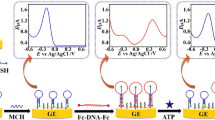Abstract
The aim of this study is to develop a selective adenosine aptamer sensor using a rational approach. Unlike traditional RNA aptamers developed from SELEX, duplex DNA containing an abasic site can function as a general scaffold to rationally design aptamers for small aromatic molecules. We discovered that abasic site-containing triplex DNA can also function as an aptamer and provide better affinity than duplex DNA aptamers. A novel adenosine aptamer sensor was designed using such a triplex. The aptamer is modified with furano-dU in the binding site to sense the binding. The sensor bound adenosine has a dissociation constant of 400 nM, more than tenfold stronger than the adenosine aptamer developed from SELEX. The binding quenched furano-dU fluorescence by 40%. It was also demonstrated in this study that this sensor is selective for adenosine over uridine, cytidine, guanosine, ATP, and AMP. The detection limit of this sensor is about 50 nM. The sensor can be used to quantify adenosine concentrations between 50 nM and 2 μM.




Similar content being viewed by others
References
Dunwiddie TV, Masino SA (2001) Annu Rev Neurosci 24:31–55
Jacobsen KA, Gao Z-G (2006) Nat Rev Drug Discov 5:247–264
Gruber HE, Hoffer ME, McAllister DR, Laikind PK, Lane TA, Schmid-Schoenbein GW, Engler RL (1989) Circulation 80:1400–1411
Conlay LA, Conant JA, deBros F, Wurtman R (1997) Nature 389:136
Castro-Gago M, Camina F, Lojo S, Ro-driguez-Segade S, Rodriguez-Nunez A (1992) Eur. J Clin Chem Clin Biochem 30:761–176
Dale NJ (1998) Physiol 511:265–272
Llaudet E, Botting NP, Crayston JA, Dale N (2003) Biosens Bioelectron 18:43–52
Xu W, Lu Y (2010) Anal Chem 82:574–578
Liu J, Lu Y (2006) Angew Chem Int Ed 45:90–94
Lu N, Shao C, Deng Z (2008) Chem Commun 6161–6163
Xiang Y, Wang Z, Xing H, Wong NY, Lu Y (2010) Anal Chem 82:4122–4129
Bekar L, Libionka W, Tian GF, Xu Q, Torres A, Wang X, Lovatt D, Williams E, Takano T, Schnermann J, Bakos R, Nedergaard M (2008) Nat Med 14:75–80
Huizenga DE, Szostak JW (1995) Biochemistry 34:656–665
Wang DY, Lai BH, Sen DJ (2002) Mol Biol 318:33–43
Coppel Y, Constant J-F, Coulombeau C, Demeunynck M, Garcia J, Lhomme J (1997) Biochemistry 36:4831–4843
Thomas F, Mi-chon J, Lhomme J (1999) Biochemistry 38:1930–1937
Sankaran NB, Nishizawa S, Seino T, Yoshimoto K, Teramae N (2006) Angew Chem Int Ed 45:1563–1568
Ong HC, Arambula JF, Ramisetty SR, Baranger AM, Zimmerman SC (2009) Chem Commun 668–670
Li M, Sato Y, Nishizawa S, Seino T, Nakamura K, Teramae N (2009) J Am Chem Soc 131:2448–2449
Thiagarajan V, Rajendran A, Satake H, Nishizawa S, Teramae N (2010) Chembiochem 11:94–100
Srivatsan SG, Tor Y (2007) J Am Chem Soc 129:2044–2053
Srivatsan SG, Tor Y (2007) Tetrahedron 63:3601–3607
Greco NJ, Tor Y (2007) Tetrahedron 63:3415–3614
Wang S, Booher MA, Kool ET (1994) Biochemistry 33:4639–4644
Lee H-T, Khutsishvili I, Marky LA (2010) J Phys Chem B 114:541–548
Sazani PL, Larralde R, Szostak JW (2004) J Am Chem Soc 126:8370–8371
Cywinski PJ, Moro AJ, Ritschel T, Hildebrandt N, Lohmannsroben H-G (2011) Anal Bioanal Chem 399:1215–1222
Acknowledgments
This research was supported by the faculty start-up fund of New Jersey Institute of Technology. We also thank Dr. Robert Donnelly of the University of Medicine and Dentistry of New Jersey for assistance in oligonucleotide synthesis.
Author information
Authors and Affiliations
Corresponding author
Electronic supplementary material
Below is the link to the electronic supplementary material.
ESM 1
PDF 687 kb)
Rights and permissions
About this article
Cite this article
Patel, M., Dutta, A. & Huang, H. A selective adenosine sensor derived from a triplex DNA aptamer. Anal Bioanal Chem 400, 3035–3040 (2011). https://doi.org/10.1007/s00216-011-4996-1
Received:
Revised:
Accepted:
Published:
Issue Date:
DOI: https://doi.org/10.1007/s00216-011-4996-1




